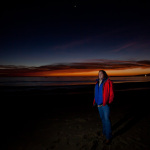As a Director of Photography just starting a new project, most times I read the script and have creative meetings with the Director about the look of the film and how to best capture that look. I try to do as much camera/lens testing as possible, have more meetings, and finally come up with a camera package that fits the look of the film as well as the budget. In the case of Passport, as I was reading the script, the only camera that was going through my mind was the Digital Bolex D16.
Continue reading “Why I chose Digital Bolex D16 to shoot “Passport””
Category: Camera Hardware
Using the iPhone as a camera
![]() It’s a terrible camera. The lens is tiny, the resolution stinks, you have no creative control over shutter speed, sensitivity, aperture, and it’s ergonomically a nightmare, not to mention, sometimes it’s a really bad phone too. But it’s always there. I’ve always got it handy when I see something I would really like to photograph and don’t have my DSLR on hand. As a result, I have a lot of photos taken with my iPhone that I wished I had a better camera for. But having taken so many photos with it, I’ve discovered something about the iCamera, or maybe I’ve discovered something about myself, because I’ve started to like the images I can create with it. Continue reading “Using the iPhone as a camera”
It’s a terrible camera. The lens is tiny, the resolution stinks, you have no creative control over shutter speed, sensitivity, aperture, and it’s ergonomically a nightmare, not to mention, sometimes it’s a really bad phone too. But it’s always there. I’ve always got it handy when I see something I would really like to photograph and don’t have my DSLR on hand. As a result, I have a lot of photos taken with my iPhone that I wished I had a better camera for. But having taken so many photos with it, I’ve discovered something about the iCamera, or maybe I’ve discovered something about myself, because I’ve started to like the images I can create with it. Continue reading “Using the iPhone as a camera”
Longboat Key, FL Sunset

Tech Scout day on Longboat Key in Florida, the afternoon was overcast and at one point it started to rain pretty hard. As the day waned the rain had moved on, but the clouds that had been left behind foretold of a bleak sunset. Most of the crew left but I stayed behind hoping something interesting might happen, and right at the tail end of sunset, the clouds started to break apart and this beautiful scene presented itself.
They named it Magic Hour for a reason.
Shooting “No Ordinary Hero” on the Canon 5D MkIII and Atomos Ninja 2
by Jeff Gatesman
I have shot a feature film called No Ordinary Hero with the new Canon 5D Mk III using the clean video output to an Atomos Ninja 2 and recording to ProRes 422 Hq. This was a conscious choice for several reasons, the main one being that we have a dozen or so FX shots, mostly green screen composites and we needed the fattest “negative” our low-budget film could afford.
I will get to the meat of the subject with camera setup and recorder settings in a moment but first let me start by addressing the fat “negative” statement (and unless you are going straight from your camera output to a finished product you need to be thinking of the files as a camera negative, or at least a starting point for your final look) because when Canon came out with the firmware update on April 30 that allowed for clean video out via HDMI on the 5D Mk III, I read a few posts where people visually compared the h.264 video from the camera to the 422 video recorded by the Ninja. The conclusion that there was no discernible difference visually between the files is as expected–the codecs were doing their job, compressing and decompressing the file so that in the end they look like HD video. This is not the point of recording 422 Hq over h.264. The reason for recording the raw video to 422 Hq is to get as much information as possible for the post workflow in order to be able to cut keys easily, and color time the final film without the degradation that begins with a lossy codec like h.264.
If you compare the two codecs you can easily see the difference: h.264 is an 8-bit codec using 4:2:0 chroma subsampling, and the Ninja 2 records Pro Res 422 Hq at 10 bits using 4:2:2 chroma subsampling. A simplified comparison is that the identical files as recorded from the 5D Mk III on cf card vs the Ninja 2 weigh in at 129 MB vs 863 MB respectively. That is almost 7 times as much information in the Pro Res files. In order to make the files so miniscule, the h.264 codec has to throw away valuable information during the compression process and rely on interpolation to recreate it during decompression. You can see the effects of a lossy codec by viewing the frame grabs below, taken from the actual footage from No Ordinary Hero and cropped at 100%.


Notice how much sharper and higher contrast the image from Pro Res looks. Continue reading “Shooting “No Ordinary Hero” on the Canon 5D MkIII and Atomos Ninja 2″
Balancing Sunset with a Foreground Subject, part 1
A technique I have been wanting to try for a long time now has been balancing a beautiful sunset with a good exposure on a person in the foreground. It’s not entirely simple as the subject should not be lit flat like from an on-camera flash, and the proper balance has to be found. This is my first attempt and I did not have the flash set up properly and didn’t have all the equipment I would have wanted because we just happened to be driving by the beach when we saw this sunset and ran out to grab some photos, but I made do and these are the images I came up with. Thanks to my buddy Bret for being such an accommodating victim. I learned a few things just from that brief foray and will refine the technique from here.









